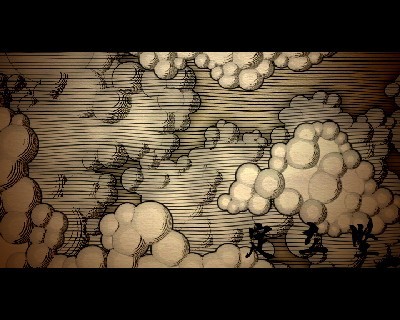Human Facial Anatomy and Expressions, and how they can be Realistically Represented using Computer Graphics

Facial animation is the most important part of character animation, and realistic and natural expression of emotions is one of the most important parts of animating a believable character. This, however, is also one of the most challenging aspects of animating a character. The human face is one of the most interesting and intricate parts of the human body. We can detect even the subtlest change of expression within the face, and its familiarity allows us to recognise one face out of a sea of hundreds that we come into contact with every day. In order to successfully animate facial expressions and emotion, a thorough understanding of the human facial muscular structure and how expressions are formed is necessary.
A Procedural Approach to Non-Photorealistic Rendering of Pen and Ink Illustration from Three-Dimensional Models

This paper is concerned with the development of non photorealistic rendering in the form of pen-and-ink illustration. In particular, I will be presenting two methods of shader creation through the RenderMan process, a two-dimensional method that involves striping along the u and v directions of an object and a three-dimensional method that is based on solid texturing. Non-photorealistic rendering (NPR) is still a relatively new area in computer graphics but has developed a strong appreciation in recent years. In this report, related work in this field will be briefly addressed and then the development of my own techniques will be explained. Finally, an animated short will be created using the shader, intending to emulate the aesthetics of traditional Pen and Ink illustration in a digital medium.
Non Photorealistic Rendering of Water in Hayao Miyazaki Style
The object of this project is to introduce a drawn animation style and to replicate it in computer graphics using the available software tools, in order to produce a similar result as that used as inspiration. The state of contemporary animation is reviewed in an attempt to justify the chosen topic, and a solution to the proposed task is presented, as well as a description of the paths taken to arrive at the result.
Innovations
This project is a character driven animation limited on a minimum amount of visual information to communicate a story. All the visual elements are restrained to the simplest essence of form in space, the silhouette. Such restriction implies the lack of many of the natural visual properties, such as color, tone and texture, which are key elements for the perception of depth, volume and light. Using only black orwhite and the filled shape of the characters and the environments I would like to explore and demonstrate the power of shape in visual communication.
Real Time Animated Typography Tool

As video art becomes a more prominent part of nightclub entertainment, promoters are also becoming more aware of the advertising potential of video projected information. For the most part, financial assistance is not generally offered to produce sophisticated animated typographic sequences, rather it is an expected service to be provided as part of a show. Production of animated sequences takes time. The process involves creating the type, marking key frames or choosing paths for the type to follow, rendering and finally editing and outputting to a format to be displayed. By having a quick and easy tool to display logos and text on-screen the video artist is given more time to work on sequences outside the realms of unpaid corporate advertising.
Non-Photorealistic rendering: A Marker Technique Approach

‘Whether the object in the hand is a coloured pencil, a marker or a computer control, the basic design and visualizing skills needed to use them effectively remain the same.’ (Powell 1990 p.9)
Innovations
This project sought to research into current and past simulations, into teaching methods which use computer graphics and to make a teaching tool that would demonstrate the principles of a nuclear reaction.
The Simulation of the Aging Process and Implementing Wrinkles in Computer Animation
This report discusses the physical process of aging, including the structure of the skin and wrinkle formation. Research into different approaches using the aging process in computer graphics is documented. The report proposes a tool designed for Maya using MEL scripting that allows a user to apply wrinkles or other textures, as layered bump maps, to selected faces. Further applications and future ideas are also discussed.
Innovations
This report discusses the role of animation in education. It looks at how the human mind learns, subdividing learning into two major components: ~ UNDERSTANDING and MEMORY. It addresses the issue as to whether animation can improve both components for individuals of all learning categories: visual, auditory and kinaesthetic.
Random Face Generation and the Application of Fuzzy Logic

This paper describes a system that automatically generates multiple variations of a piece of 3D facial geometry. The position of a facial feature drives the position of another feature using a set of rules obtained through observed associations between features on a human face. The system allows for a user to modify features on a face manually. The fundamentals and power of Fuzzy Logic is explored in depth, and the potential use of this method of logic inside the system is hypothesised. It is proposed that realistic variations of a face can be generated automatically by the system, and that the need for modelling multiple faces in the 3D environment could become unnecessary by the use of this method of generation.
